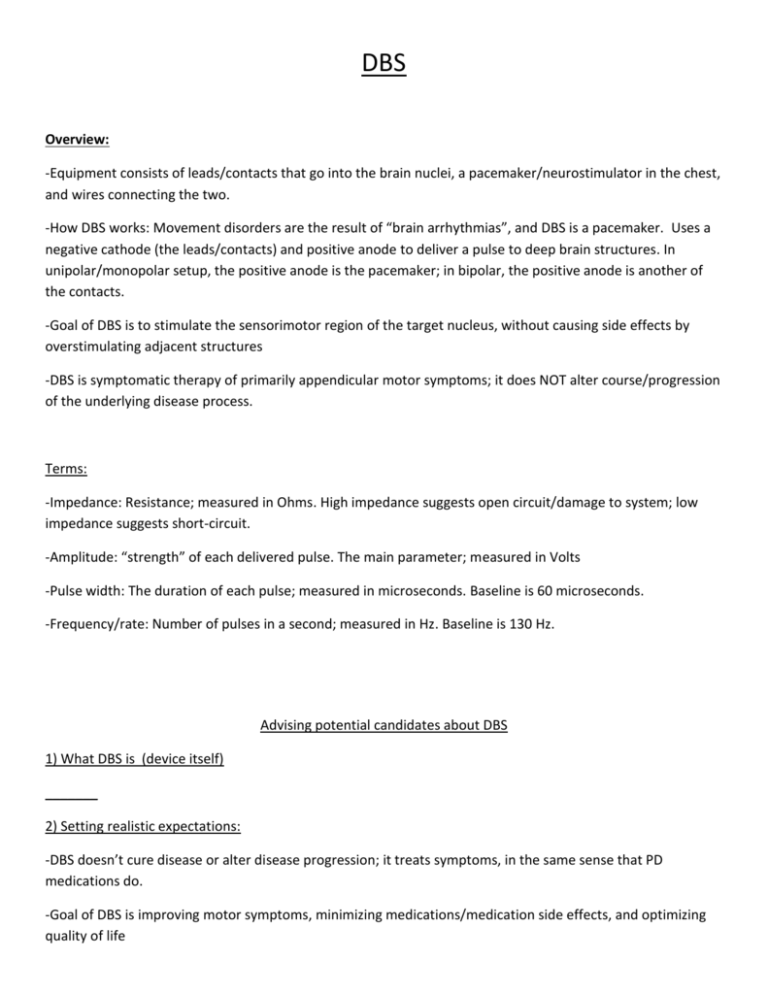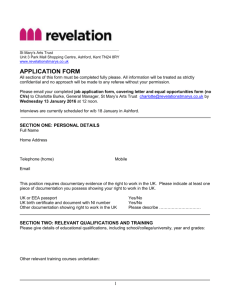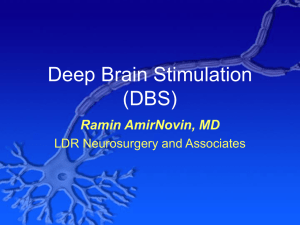1) DBS and PD
advertisement

DBS Overview: -Equipment consists of leads/contacts that go into the brain nuclei, a pacemaker/neurostimulator in the chest, and wires connecting the two. -How DBS works: Movement disorders are the result of “brain arrhythmias”, and DBS is a pacemaker. Uses a negative cathode (the leads/contacts) and positive anode to deliver a pulse to deep brain structures. In unipolar/monopolar setup, the positive anode is the pacemaker; in bipolar, the positive anode is another of the contacts. -Goal of DBS is to stimulate the sensorimotor region of the target nucleus, without causing side effects by overstimulating adjacent structures -DBS is symptomatic therapy of primarily appendicular motor symptoms; it does NOT alter course/progression of the underlying disease process. Terms: -Impedance: Resistance; measured in Ohms. High impedance suggests open circuit/damage to system; low impedance suggests short-circuit. -Amplitude: “strength” of each delivered pulse. The main parameter; measured in Volts -Pulse width: The duration of each pulse; measured in microseconds. Baseline is 60 microseconds. -Frequency/rate: Number of pulses in a second; measured in Hz. Baseline is 130 Hz. Advising potential candidates about DBS 1) What DBS is (device itself) _______ 2) Setting realistic expectations: -DBS doesn’t cure disease or alter disease progression; it treats symptoms, in the same sense that PD medications do. -Goal of DBS is improving motor symptoms, minimizing medications/medication side effects, and optimizing quality of life -Takes time for benefits to accrue, with numerous visits for reprogramming -Decreases need for meds, but doesn’t eliminate them entirely 3) How DBS pathway/evaluation process works: -2 months, at least 3 trips. Involve videotaping, neurosurgical evaluation, social work, SLP, neuropsych, MRI. Then gather and discuss as a team. Involves 2 separate surgeries (first is placing the wires, second is connecting to pacemaker). 4) Risks and side effects: -Major stats to mention: 5% risk of bleeding, infection, malfunction. -3% risk of a bleed occurring per lead, and 0.6-1% risk of bleed occurring that causes permanent neurologic deficits; risk of infection serious enough to need re-operation to remove part or all of equipment is 2-5%. -Other specific risks: Surgery related (hemorrhage/stroke 1-5%, DVST, seizure 3%, PE 0.4-4.9%, PNA 0.6%, perioperative confusion 1-36%, suboptimal lead placement 3.8-12%), device-related (infection 3-10%, skin erosion 2.5-6.5%, electrode/wire fracture 5.1-18%, neurostimulator malfunction/migration 18%, pain over neurostimulator 11-36%). -Can also worsen cognition, speech. -Better than pallidotomy: Reversible, adjustable. -STN side effects: Parasthesias, dyskinesias, muscle contractions, dysarthria, gait/posture instability, diplopia/eye movement problems, eyelid opening apraxia, post-op confusion, emotionality, flushing, hypomania/anxiety/depression/psychosis, dysphagia, weight gain. -GPi side effects: Muscle contractions, dysarthria, visual phemonen. -Vim side effects: Parasthesias, muscle contractions, dysarthria, postural instability/ataxia. 5) Trouble-shooting DBS (generally): -Is the device on? Is it out of battery life? check these parameters -Is it open circuit (high impedance) or short circuit (low impedance)? if concern for open circuit, get xray shunt series to look for breaks/kinks -Misplaced lead (side effects at low amp, or no benefit or side effects even at high amp)? -Signs of infection PO or IV antibiotics; may need to remove and replace DBS if severe, deep, or refractory. -Intolerable side effects switch to Bipolar (this is less effective for symptoms, but potentially can improve side effects; Pick the two best contacts, the BEST is negative, other is positive; bump voltage up by 0.5 to account for change). -PD and severe dyskinesias: Reduce meds “interleaving” (using 2 different contacts, each with different voltages (vs. double monopolar, which has to have the same voltage), which can improve dyskinesias. Click “New”, then make case +, most superior electrode -, then set it. This creates two SEPARATE case positive contact negative settings. 1) DBS and PD Indications for DBS for PD: -Robust response of motor symptoms to levodopa -Current motor symptoms are disabling or limiting to patient -Currently failing optimal medical therapy -NOT at end stage of disease. -Significant on-off fluctuations -Significant dyskinesias -No significant cognitive or uncontrolled psychiatric/psychotic symptoms -No serious surgical co-morbidities -Problems with poor DBS outcome generally due to either poor patient selection, co-morbidities, suboptimal DBS lead placement, inadequate programming, or equipment/technical problems. DBS DOES: -Improve motor symptoms (bradykinesia, rigidity, tremor > gait) and fluctuations -Provide only as much benefit as the best response to levodopa. -Reduce (but not usually eliminate) medication requirements -Reduce dyskinesias -Stats: 66% improved UPDRS in 1 year, 54% in 5 years; tremor improved 75%, rigidity 71%, bradykinesia 51%, dyskinesias 58%, medication dose reduction by 60% in 1 year without further dose escalation. DBS DOES NOT: -Alter the natural course of the disease. -Improve non-motor symptoms (speech, cognition, swallowing, autonomic symptoms, mood/behavior); in fact, may WORSEN them. -Improve freezing, severe postural instability, micrographia -Improve anything that has not been improved with levodopa Lead placement location: -Generally bilateral lead placement, given that symptoms are usually bilateral -Lateral STN or posterior GPi are both good choices, treating tremor AND parkinsonism; VIM only treats tremor, and thus is not the preferred location for PD. -Prior pallidotomy does not exclude patient from future DBS Predictors of success/failure: -Best response to levodopa -Problems with poor DBS outcome generally due to either poor patient selection, co-morbidities, suboptimal DBS lead placement, inadequate programming, or equipment/technical problems. Considerations and specific side effects: -Side effects: Hypomania, worsening balance/falls/cognition/mood/dysarthria, muscle contractions, emotionality, diplopia, flushing, parasthesias, freezing. Initial post-op programming for PD: -Wait 3-4 weeks after implantation before programming, so that the microlesion effect has time to wear off. Patients should arrive OFF medications. Good to bring family member. Make sure they are off medications for at least 1-2 doses/the night before. 1) Questions to ask: Any microlesion effect (transient improvement after surgery lasting days to weeks; can be good sign of correct electrode placement)? Any pain, swelling, f/c, redness, itchiness, or discharge at surgery sites? How do chest and head incision sites look? 2) Exam: Check focused Parkinson symptoms (pick one symptom, such as tremor/rigidity> bradykinesia, to focus on for programming). Feel along leads for any abnormalities, tenderness, redness, swelling. The actual programming part: -Place sleeve and probe over pacemaker; turn on your device, click DBS, press P button on side. Record battery life, DBS model. -Check impedance (ruler button), choose “electrode” setting, then pick side, click unipolar, click settings, make V=3, click ok; record impedance and current. Goal impedance is around 800-1500 ohms; if not in that range, unlikely that Contact will be viable. -Click Lead icon and then “manual” to start titrating Amp to efficacy. -Click the tiny pacemaker icon and then Contact 0. Start with pulse width 60, rate 130, amp 1.0 V. Increase by 0.5 V increments until get benefit. Then continue to increase by 0.5V intervals until you get to 5.0 V, or side effects occur (whichever happens first). -Then, return amp to 0, wait a bit, then pick Contact 1, repeat on that one, etc. until all Contacts tested. Do the same for the other side too. Make sure to record for each Contact the minimum voltage/pulse/frequency that controlled tremor, and the minimum voltage that caused side effects. -End goal Amp should be around 1.5-2.0, or the lowest amp possible that improves symptoms. If get to Amp of 3V or higher without benefit or get side effects before symptom improvement, consider instead increasing pulse width or frequency (to 185). -In the end, use the Contact that has the largest “therapeutic window” ( difference between the voltage needed to improve symptoms, and the voltage that causes side effects; ie, prefer the Contact that controls symptoms at 2V with side effects at 4.5V, compared to other Contact that controls symptoms at 2V but has side effects at 3V), to ensure you have more room to go up in the future in the way that is best tolerated. -Other options include increasing pulse width (60-120 microseconds) or frequency (130-185 Hz). -Set it to the ideal Contact settings you’ve found, provided amp is 1.5-2.0 -Once done, click door icon, end session, record final settings; then click door icon again, click patient programming, click advanced. -Finally, show the patient how their personal remote works: A) How to check if their DBS is on/off (hold remote over pacemaker, hold yellow button until beep); they should check this every night. B) How to turn DBS on/off (hold remote over pacemaker, hold grey button until beep). -Have them take their meds in the office, then wait 30 minutes in waiting area and then reassess in case they develop severe dyskinesias. -If they had significant pre-op dyskinesias, take this time to drop their meds a bit (discontinue comtan or dopamine agonist or MAOI-B > sinemet decrease) -Remind/warn of contraindicated procedures for DBS (MRI, diathermy); remind that there may be delayed onset dyskinesias, and to adjust meds to compensate for that. Warn that power tools could turn it off. Follow-up programming for PD: -Exam: Focused PD exam. Symptoms that are most bothersome? Meds currently on? -Place sleeve and probe over pacemaker; turn on your device, click DBS, click P. -Record Amp, pulse width, and frequency for EACH Contact, on EACH side (0-3 are on left, 8-11 are on right), battery life, % time device is on, whether it is CURRENTLY on. -Check impedance (ruler button), choose therapy setting; record values. Goal is around 1000 ohms -Click Lead icon and then “manual” to start making adjustments. -This visit, make 2 separate program settings, A (new settings from the visit) and B (old settings, what it was set at when they came to the visit). Under the Lead icon, click “New Group”, then set the settings for A and B. -Explaining how patients can switch from setting A to B: On their device, highlight A, toggle right, highlight B, toggle right, then hit right again, then hit yellow button to set. Trouble-shooting DBS specifically for PD: -Dyskinesias: Often exacerbated after initial programming session; try to tough it out a couple of says, as it often improves after that. If not, stop sinemet for a day and then restart once things quite down; if necessesary, reduce dose of Comtan >DA > MAOB-I > levodopa. If that not work “interleaving” (using 2 different contacts, each with different voltages (vs. double monopolar, which has to have the same voltage), which can improve dyskinesias. Click “New”, then make case +, most superior electrode -, then set it. This creates two SEPARATE case positive contact negative settings. -Dysarthria: Turn down the leads on one side; speech therapy. -Worsening PD motor symptoms: Disease progression >>>lead migration. -Gait instability/freezing: Figure out if it is an on or off phenomenon; PT, change contact, change frequency to 60 (though may worsen tremor), make stimulation unilateral (worsens one side), surgical readjustment of leads. -Eyelid opening apraxia: Botox. -Post-op memory problems: may be result of “air on brain” from surgery, resolves over weeks. -Last resort for side effects: reposition DBS leads ============================================================================== 2) DBS and ET: Indications for DBS for ET: -Adequate confidence in the correct diagnosis of ET -Robust response of motor symptoms to levodopa -Current tremor is disabling or limiting to patient -Failed adequate trials of beta blocker, primidone, and Topamax. -No significant cognitive or uncontrolled psychiatric/psychotic symptoms -No serious surgical co-morbidities Lead placement location: -VIM nucleus of thalamus is gold standard -Unilateral placement in first surgery, as this is usually adequate; later, can do other side also but bilateral lead placement increases risk of mild speech problems and balance problems. Considerations: -DBS doesn’t help with head or voice tremor (not work well for midline problems) -Over time, try to wean tremor meds, but they may be needed for the OTHER hand -Wait at least 6 months after DBS surgery for one side before considering DBS surgery for the other side (many people only need one side functional) -Potential side effects: Dysarthria, sensory changes, incoordination, pain, abnormal thinking, headache. -Post-surgical side effects: confusion (lasting days to weeks), worsened dyskinesias, Initial Post-op programming for ET: -Wait 3-4 weeks after implantation before programming, so that the microlesion effect has time to wear off. Patients should arrive ON medications. Good to bring family member. 1) Questions to ask: Any microlesion effect (transient improvement after surgery lasting days to weeks; can be good sign of correct electrode placement)? Any pain, redness, f/c swelling, itchiness, or discharge at surgery sites? How do chest and head incision sites look? 2) Exam: Tremor position that most brings out tremor; that is the position to repeatedly assess while programming. Record baseline level of tremor. Feel along leads for any abnormalities, tenderness, redness, swelling. The actual programming part: -Place sleeve and probe over pacemaker; turn on your device, click DBS, click P. -Check impedance (ruler button), choose ““electrode” setting, then pick side, click unipolar, click settings, make V=3, click ok; record impedance and current. Goal is around 1000 ohms. Record battery life. -Click Lead icon and then “manual” to start titrating Amp to efficacy. -Click the tiny pacemaker icon and then Contact 0. Start with pulse width 60, rate 130, amp 1.0 V. Increase by 0.5 V increments, waiting a minute or two until tremor disappears. Record voltage it disappears at. Then continue to increase by 0.5V intervals until you get to 5.0 V, or side effects occur (whichever happens first). -Then, return amp to 0, wait until tremor returns, then pick Contact 1, repeat on that one, etc. until all Contacts tested. Make sure to record for each Contact the minimum voltage/pulse/frequency that controlled tremor, and the minimum voltage that caused side effects. -End goal Amp should be around 1.5-2.0, or the lowest amp possible that abolishes tremor. If get to Amp of 3V or higher without benefit or get side effects before tremor controlled, consider instead increasing pulse width or frequency (to 185). Contact 1 > 2 are usually the “best” that minimize side effects. -In the end, use the Contact that has the largest “therapeutic window” ( difference between the voltage needed to abolish tremor, and the voltage that causes side effects; ie, prefer the Contact that abolishes tremor at 2V with side effects at 4.5V, compared to other Contact that abolishes tremor at 2V but has side effects at 3V), to ensure you have more room to go up in the future in the way that is best tolerated. -Other options include increasing pulse width (60-120 microseconds) or frequency (130-185 Hz) or have 2 active electrodes (double monopolar, which stimulates a larger area). Can also use Softstart/softstop option to make it turn on more gradually each time if initial surge is too jarring. -Finally, show the patient how their personal remote works: A) How to check if their DBS is on/off (hold remote over pacemaker, hold yellow button until beep); B) How to turn DBS on/off (hold remote over pacemaker, hold grey button until beep). -Remind/warn of contraindicated procedures for DBS (MRI, diathermy); also remind them to turn off DBS at bedtime, turn it on in AM (to conserve battery life). Warn that power tools could turn it off. Follow-up programming for ET: -Exam: Focused tremor exam. Side effects? -Place sleeve and probe over pacemaker; turn on your device, click DBS, click P. -Record Amp, pulse width, and frequency for EACH Contact, battery life, % time device is on, whether it is CURRENTLY on. -Check impedance (ruler button), choose therapy setting; record values. Goal is around 1000 ohms -Click Lead icon and then “manual” to start making adjustments. -This visit, make 2 separate program settings, A (new settings from the visit) and B (old settings, what it was set at when they came to the visit). Under the Lead icon, click “New Group”, then set the settings for A and B. -Explaining how patients can switch from setting A to B: On their device, highlight A, toggle right, highlight B, toggle right, then hit right again, then hit yellow button to set. Trouble-shooting DBS specifically for ET: -Visual phenomenon: use more dorsal contacts. -Last resort for side effects: reposition DBS leads ============================================================================== 3) DBS and Dystonia: Indications for DBS for dystonia: -Adequate confidence in correct diagnosis of dystonia, ruling out alternative causes. -Failed trial of sinemet (to rule out dopa-responsive dystonia); _______ ? medication trial Predictors of success: -Primary > secondary dystonia -DYT1/juvenile onset generalized >>> segmental or focal -Wide range of potential outcomes; 50-70% odds of SOME response; if gets SOME response, improvement will be 20-70%. Lead placement location: -Generally do GPi Considerations: -Microlesion effects are rare in DBS for dystonia -Potential side effects: Bright visual phenomenon, tonic muscle contractions, dysarthria, dyskinesia Initial Post-op programming for Dystonia: -Wait 3-4 weeks after implantation before programming, so that the microlesion effect has time to wear off. Patients should arrive ON medications. Good to bring family member. 1) Questions to ask: Any microlesion effect (transient improvement after surgery lasting days to weeks; can be good sign of correct electrode placement, though rare after dystonia DBS surgery)? Any pain, swelling, itchiness, or discharge at surgery sites? How do chest and head incision sites look? 2) Exam: Find one aspect of dystonia to note and follow over time. Record baseline level of dystonia. Feel along leads for any abnormalities, tenderness, redness, swelling. The actual programming part: -Place sleeve and probe over pacemaker; turn on your device, click DBS, click P. -Check impedance (ruler button), choose ___ setting; record values. Goal is around 1000 ohms. Record battery life. -Click Lead icon and then “manual” to start titrating Amp to efficacy. -Click the tiny pacemaker icon and then Contact 0. Start with pulse width 60, rate 130, amp 1.0 V. Increase by 0.5 V increments. Then continue to increase by 0.5V intervals until you get to 5.0 V, or side effects occur (whichever happens first). -Then, return amp to 0, then pick Contact 1, repeat on that one, etc. until all Contacts tested. Make sure to record for each Contact the minimum voltage/pulse/frequency and the minimum voltage that caused side effects. -Other options include increasing pulse width (60-120 microseconds) or frequency (130-185 Hz). -Finally, show the patient how their personal remote works: A) How to check if their DBS is on/off (hold remote over pacemaker, hold yellow button until beep); B) How to turn DBS on/off (hold remote over pacemaker, hold grey button until beep). -Remind/warn of contraindicated procedures for DBS (MRI, diathermy, metal detectors). ------------------------------------------------------------------------------------------------------Miscellaneous: Side effects by anatomic localization: A) STN: Speech/motor = internal capsule/too anterior or lateral; parasthesias = medial lemniscus/ too posterior; eye deviation = too medial and deep; mood/cognition = too medial; eyelid opening apraxia= too dorsal. B) GPi: Ventral for PD is better for rigidity and dyskinesia, dorsal for bradykinesia. Visual phenomenon = too deep; speech/motor= too posterior/medial. C) VIM: parasthesias = too posterior; dysarthria = too deep/posteromedial; tonic muscle contractions= too lateral/posteromedial/internal capsule. Billing for programming session: -99999; then do charge capture, use 95978 (if made new changes with session <1 hour) + 95979 (each additional half hour beyond 1 hour) vs. 95970 (programming session with no changes made). Neurophysiology in the OR: -STN: noisier, higher amplitude background punctuated by irregular occasional blips. Usually around 15-20mm deep -SNr: Regular bursts of similar activity; STN -Thalamus: Don’t really listen for a pattern. You go 15mm deep, then provide stimulation to (ideally) get paresthesias in the contralateral hand (that go away below 3-3.5 V) without other side effects, and suppression of tremor. Programming in the OR: -Connect DBS computer to the DBS, increase by 1V at a time to max of 5V, watching for side effects (paresthesias, motor contractions, speech changes, cognitive changes) and to a lesser extent improved symptom control. Goal is no persistent side effects below 3V. If all leads get side effects at 3V or lower, may suggest placement is not ideal (and would make for harder programming later) so repositioning is likely warranted.



